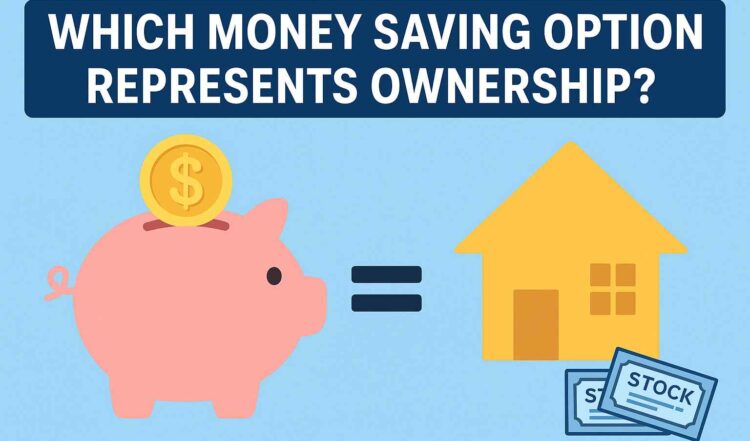When it comes to managing money, people often ask themselves: “Should I keep my money in a savings account, or should I invest it somewhere that gives me ownership?” The difference may seem small at first, but it’s a crucial one. Some saving options simply store your money safely, while others give you ownership of real assets that can grow in value over time.
Understanding which money-saving options represent ownership is the first step toward building long-term wealth. Let’s break it down clearly, with real-world examples of banks, financial institutions, and assets you’re likely familiar with.
Common Money Saving Options (Overview)
Before we figure out which ones represent ownership, let’s list the most common places where people save their money:
-
Savings Accounts – Offered by banks like Chase, Wells Fargo, Bank of America, Navy Federal Credit Union.
-
Certificates of Deposit (CDs) – Time-locked deposits where money earns fixed interest.
-
Government Savings Bonds – Such as U.S. Treasury Bonds, Series EE and I bonds.
-
Money Market Accounts – A type of high-yield savings account.
-
Retirement Accounts – 401(k), Roth IRA, Traditional IRA.
-
Stocks & Equities – Buying ownership shares in companies like Apple, Microsoft, Tesla.
-
ETFs & Mutual Funds – Bundled investments offered by Vanguard, Fidelity, BlackRock.
-
Real Estate – Buying property, land, or rental homes.
-
Precious Metals – Owning physical gold, silver, or platinum.
Now, let’s see which of these options are ownership-based and which are not.
Which Money Saving Options Do NOT Represent Ownership?
Several saving tools are safe and low-risk, but they don’t give you direct ownership of assets. Instead, you’re simply lending your money or depositing it for safekeeping:
-
Savings Accounts
-
You deposit money at a bank, and they use it to lend out.
-
Insured by the FDIC up to $250,000 per depositor.
-
You don’t own anything except the promise that your money will be there when you need it.
-
-
Certificates of Deposit (CDs)
-
Offered by banks like Wells Fargo or Bank of America.
-
You lock in your money for a set term and earn fixed interest.
-
No ownership of assets—just a loan to the bank.
-
-
Government Savings Bonds
-
Example: Buying a U.S. Treasury EE Bond.
-
You are lending money to the government, not owning part of it.
-
Safe, but limited growth potential.
-
-
Money Market Accounts
-
A type of savings account that may pay slightly higher interest.
-
Similar to CDs and savings accounts, no ownership of assets.
-
In short, these options are secure and low risk, but they don’t represent ownership.
Which Money Saving Options Represent Ownership?
Now let’s look at the saving and investment tools that give you actual ownership of assets:
-
Stocks / Equities
-
Buying shares of companies like Apple (AAPL), Tesla (TSLA), Microsoft (MSFT) makes you a part-owner of the company.
-
Benefits: Potential dividends, voting rights, and value appreciation.
-
Example: If Apple’s stock price rises from $150 to $200, your ownership value increases.
-
-
Mutual Funds & ETFs
-
Instead of owning one company, you own a bundle of companies or bonds.
-
Example: Vanguard S&P 500 ETF (VOO) or SPDR S&P 500 ETF (SPY).
-
Represents indirect ownership of hundreds of companies at once.
-
-
Real Estate
-
Buying a house, rental property, or land = direct ownership.
-
You can earn rental income and benefit from property appreciation.
-
Example: Buying a $200,000 home in Raleigh, North Carolina, that grows to $250,000 in value over 5 years.
-
-
Precious Metals (Gold & Silver)
-
Buying physical gold coins or silver bars = full ownership of the asset.
-
Difference: ETFs like GLD represent paper ownership, while bullion = direct physical ownership.
-
-
Retirement Accounts (Ownership-Linked)
-
Retirement accounts like 401(k), Roth IRA, or Traditional IRA can represent ownership if invested in stocks, ETFs, or real estate funds.
-
If left in cash, they function like savings accounts (no ownership).
-
Key Differences: Saving vs. Ownership
Here’s how ownership and non-ownership saving options differ:
| Option | Ownership | Risk Level | Example Entity |
|---|---|---|---|
| Savings Account | ❌ | Low | Bank of America, Chase |
| Certificate of Deposit | ❌ | Low | Wells Fargo, Navy Federal CU |
| Treasury Bond | ❌ | Low | U.S. Treasury |
| Stocks/Equities | ✅ | High | Apple, Tesla, Microsoft |
| Real Estate | ✅ | Medium | Residential or rental homes |
| Gold/Silver | ✅ | Medium | Bullion, U.S. Mint coins |
| ETFs/Mutual Funds | ✅ | Medium | Vanguard, Fidelity, BlackRock |
Non-ownership savings = safety but limited growth.
Ownership-based savings = risk but potential wealth-building.
Which Ownership Option is Best for You?
Not all ownership savings are equal. The “best” one depends on your goals:
-
Beginner Investors → Start with ETFs or index funds (low-cost, diversified).
-
Long-Term Growth → Stocks (equities) in companies with strong track records.
-
Wealth Building & Stability → Real Estate for long-term asset appreciation.
-
Inflation Hedge → Gold or Silver to preserve value when currency weakens.
-
Conservative Approach → Keep a mix of savings accounts (for safety) and ETFs (for ownership).
Frequently Asked Questions
1. Is a savings account considered ownership?
No. It’s a deposit tool, not an ownership stake in any asset.
2. Do government bonds give me ownership?
No. Bonds make you a lender, not an owner.
3. What’s the safest ownership-based option?
Broad-market ETFs like Vanguard S&P 500 ETF (VOO) or real estate.
4. Do retirement accounts represent ownership?
Yes, if they’re invested in assets like stocks or real estate funds.
5. Should I choose ownership or non-ownership savings?
Ideally, a mix: keep some money safe in savings/CDs, and allocate some toward ownership-based assets for growth.
Conclusion
So, which money saving option represents ownership? The answer is stocks, ETFs, real estate, and precious metals. These options give you a stake in actual assets that can appreciate in value and generate income.
On the other hand, traditional savings tools like bank accounts, CDs, and bonds are secure but don’t represent ownership—they simply store or loan your money.
If your goal is wealth-building, ownership-based savings are the key.
If your goal is safety, non-ownership tools like savings accounts and bonds are a better fit.
The best approach? A balanced mix that combines the security of non-ownership savings with the growth potential of ownership-based investments.



Leave Comment